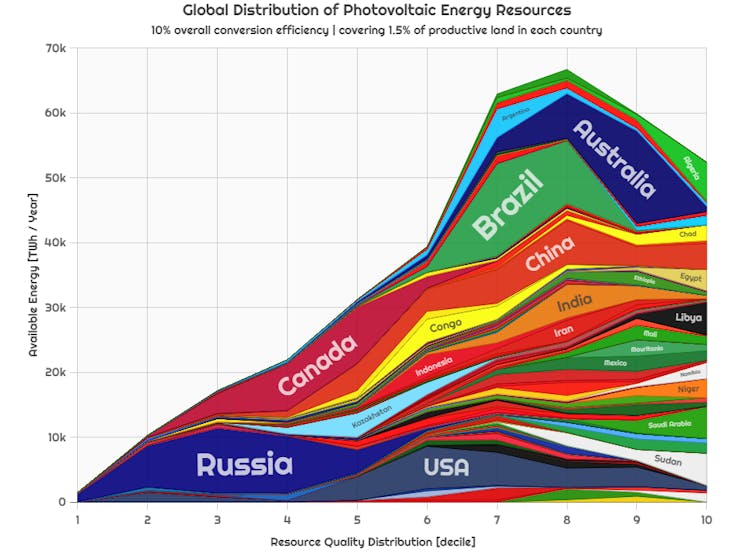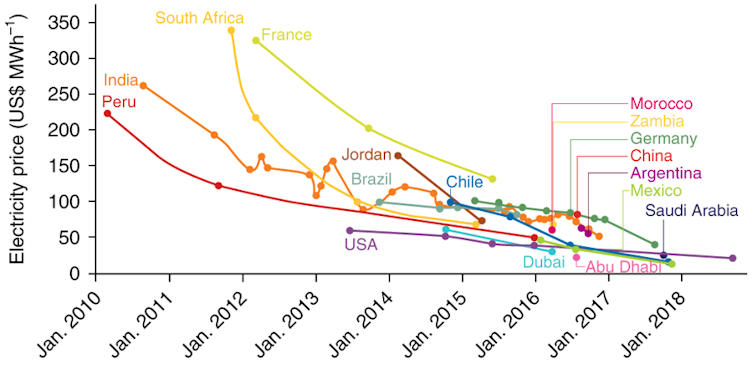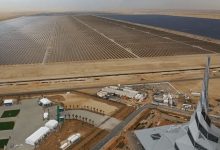Every now and then, the idea of powering Europe using the vast solar resources of the Sahara Desert comes up. Were this to actually happen, we may witness the rise of new energy superpowers in Northern Africa. But a look at the economic and political energy system suggests what’s more likely is the oil-rich countries of the Arabian (or Persian) Gulf will continue to dominate energy trade even in the post-fossil era.
Renewable energy, of course, is very location dependent – the sunnier a place is, the more energy you get out of photovoltaic panels. Over the course of a year, southern Algeria, for example, gets more than twice as much solar energy as southern England. The graph below, which I put together as part of my PhD, shows that some of the best solar resources in the world are indeed found in Algeria, Libya, Egypt, Niger, Chad and Sudan.

Denes Csala / NREL, Author provided
So, one could build large Saharan solar farms and then transmit the power back to densely populated areas of Europe. Such a project would need to overcome various technical challenges, but we can say that in theory it is possible, even if not practical.
Yet plans to actually set up mass Saharan solar have floundered. The most notable project, Desertec, was fairly active until the mid 2010s, when a collapse in the price of oil and natural gas made its business case more difficult. At that time, the major technology considered was concentrated solar power, where you use the heat from the sun to run a steam turbine. Energy can be stored as heat overnight, therefore enabling uninterrupted energy supply and making it preferred to then expensive batteries.

Nature
Since then, however, the cost of both solar panels and battery storage have dropped drastically. But, while conditions might look favourable for Saharan solar, it is unlikely that new solar energy kingpins will arise in North Africa. Instead, we should look one desert further to the East – the Rub al Khali on the Arabian peninsula, the home of the reigning energy powers.
Sun shines on the Gulf
The economies of the United Arab Emirates, Saudi Arabia, Qatar and the other Gulf nations are built around energy exports. And as climate change imposes pressure on the extraction of fossil fuels, these countries will have to look for alternative energy (and income) sources in order to keep their economies afloat. The International Renewable Energy Agency set up its headquarters in Abu Dhabi, and the region has no shortage of ambitious solar projects promising extremely cheap electricity. However only a small amount of capacity has actually been deployed so far. Low oil revenues have not helped with the megaprojects.
Countries in the Sahara also have little history of trading fossil fuels, outside of Libya and Algeria, while things are rather different for the petro-states of the Gulf. And this matters because, in the energy business, worries over longer-term security of supply mean countries tend to trade with the same partners.
This would be the Achilles’ heel of a Northern African energy project: the connections to Europe would likely be the continent’s single most important critical infrastructure and, considering the stability of the region, it is unlikely that European countries would take on such a risk.
Which brings us to an alternative way to transmit energy: hydrogen. A process called electrolysis can use renewable electricity to split water into hydrogen and oxygen, and the resulting hydrogen can store lots of energy. Soon it will become feasible to move energy around the world in this form, using shipping infrastructure similar to that already in use today for liquefied natural gas.
Sure, there are disadvantages compared to batteries. It would mean introducing two more conversion stages and thus reduced efficiency (30% roundtrip efficiency compared to 80% for batteries), but it would overcome the distance barrier. And perhaps just as importantly: shipping energy by hydrogen would mean no significant change to the existing maritime trade infrastructure, which will hand an advantage to established energy exporters.
If this means the Sahara is unlikely to develop renewable energy superpowers, then perhaps this is for the better. With the booming populations of Sub-Saharan Africa in dire need of electrification, clean solar power might be better used to alleviate the energy crisis in somewhere like Nigeria rather than sent to Europe. While these countries may eventually be able to shake off any solar resource curse, in the short term, exports like these could just look like yet another European attempt to extract natural resources from Africans.

Dénes Csala, Lecturer in Energy Storage Systems Dynamics, Lancaster University
This article is republished from The Conversation under a Creative Commons license. Read the original article.










